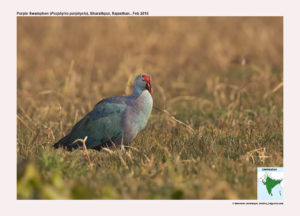Purple Swamphen

Purple Swamphen Porphyrio porphyria
Etymology:
- Porphyrio : Latin word for Swamp hen
- Porphyria : Latin word for Swamp hen
Vernacular names: Persian: Bistuni, Hindi: Kaim, Kalim, Kharim, Khima, Jamni vanmurghi, Khima Jalmurgi, Sans: Rajiv ambukukkuti, Bi: Karim, Korma, Kash: Wan tech, Pun: Nili jal-kukri, Ben: Kaim, Kam pakhi, Ass: Kaam sorai, Cachar: Kaim, B’ desh: Lili jalal kauri, Mani:Umu, Guj: Neel kukadi, Nil jalamurgho, Mar: Jambhli pankombdi, Kambala pitte, Te: Nila bolli kodi, Ooda bolli kodi, Ta: Jumbu kozhi, Mal: Neela kozhi, Sinh: Kitta, Kittala
Distribution in India: Widespread resident in India.
Description: Size of 38–50 cm; wt. of male 720–1000g, wt. of female 520–870g. It has a very large, ponderous tail. I has a massive triangular red bill, red shield, red legs and long, slender toes. It has predominantly blue to violet on head and body, with contrastingly blackish or greenish back and upperwing-coverts. The female is smaller, with smaller frontal shield. The immature is similar to adult but duller; some juvenile body feathers often retained. The juvenile is duller than adult, its face, foreneck and breast washed grey and throat almost white ,wings as adult; bare parts duller than adult.
Habitat: It is found in fresh or brackish, sheltered open waters, still or slow-flowing, and on small waters. It also inhabits ponds, lakes, dams, marshes, swamps, rivers, floodplains, artesian and seismic bores, and sewage farms. It occurs from sea-level to 2500 m.
Food habits: It eats shoots, leaves, roots, stems, flowers and seeds of aquatic and semi-aquatic plants, molluscs, leeches, small crabs, insects and their larvae, spiders, fish and their eggs, frogs and their eggs, lizards, snakes, birds, their eggs and nestlings, small rodents, and carrion. It forages in cover, at edge of cover on muddy, sandy or hard shoreline, in shallow water and on floating vegetation. It swims little, but will dabble near shallow and picks insects from water surface. It climbs freely to strip flowers and seeds from reeds and to take bird eggs and nestlings. It uses the bill to cut, dig up or pull out plants, to move stones and gravel, to turn over matted vegetation, and to dismember food items, and foot to grasp and manipulate food. It will forage in pasture, scrub and mown fields, grazes clover and grass; also feeds in rice fields. It feeds mainly in early morning and late evening; sometimes at night.
Breeding habits: They breed in Mar-Jun in Mediterranean, in Jun–Sept India and Pakistan, Jan in Madagascar, all months in Australia and Aug- Feb in New Zealand. Social structure and mating system is complex groups, it contains breeding males and females, and non-breeding helpers (offspring from previous mating). Mate-sharing occurs and females lay in communal nest; all group members care for young. They nest in shallow water, concealed in thick emergent vegetation. The nest is a large, substantial structure of dead stems and leaves of water plants, with shallow cup, usually built on platform of beaten-down vegetation just above water but sometimes floating and surrounding stems pulled over to form canopy with some access ramps provided. Some material often added during incubation. Both the sexes build the nest, with assistance from helpers. They lay a clutch of 3–5 eggs laid at daily intervals. In communal breeders all breeding females in group lay eggs in same nest, sometimes in double bowl; lays up to 3 replacements clutches after losses. The incubation period is 23–27 days and incubation done by both sexes and helpers. The hatching is synchronous or asynchronous and chicks precocial and nidifugous. The hatchlings can leave nest soon after hatching but often remain on nest for first few days. They are fed and cared for by parents and helpers. The young begin feeding themselves by 10–14 days, but still fed for 25–40 days. They fledge by 60 days and become independent by 6–8 weeks.